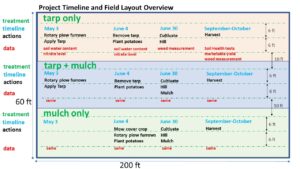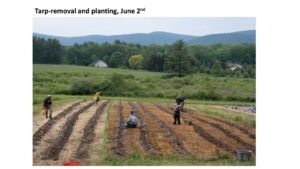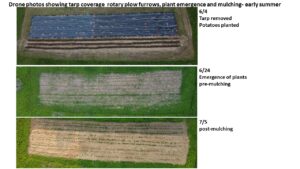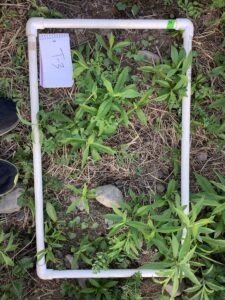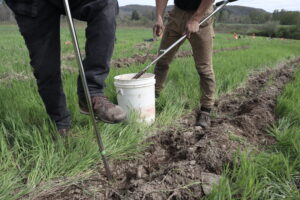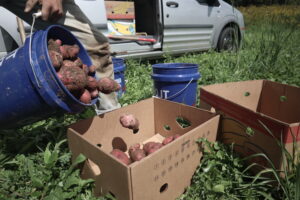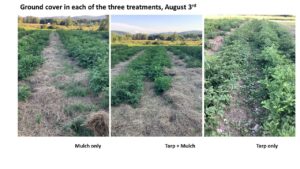Final report for FNE21-995
Project Information
This project sought to optimize a reduced-tillage, small scale commercial potato growing method by using tarping as a method to improve cover crop termination, weed suppression, soil moisture retention, and labor use. We compared three experimental growing methods: tarping with mulching (T+M), tarping without mulching (T), and no tarping with mulching (M). For each method, potatoes were planted into a reduced-tillage strip following an over-wintered cereal rye cover crop that was terminated by either tarping or flail mowing. We found that tarping was very successful at eliminating regrowth of the rye cover crop, provided some season-long weed suppression, and was associated with increased soil nitrate levels (~4 times higher than in the non-tarped plot). These benefits of tarping likely accounted for the increased yield of marketable tubers in the tarped plots. Our analysis of labor hours indicated that while tarping required an investment of labor, it is likely offset by the increased yield, especially when combined with mulching. This research was presented at two farming conferences, PASA Sustainable Agriculture and Empire State Producers Expo, both in winter of 2022. We are finishing up an educational video that highlights the inspiration for this work that will be available in the Cornell Small Farms YouTube channel. Our research will be summarized in an article that we submitted for publication to the Cornell Small Farms Quarterly.
This project sought to optimize a reduced-tillage potato growing method by using tarping as a method to improve weed suppression, moisture retention, and labor use. We compared three experimental growing methods: tarping with mulching (T+M), tarping without mulching (T), and no tarping with mulching (M). For each method, potatoes were planted into a reduced-tillage strip following a cereal rye cover crop.
Our objectives were to evaluate if and how tarping and mulching can:
1) Terminate a cereal rye cover crop, increase soil nitrate and reduce early season weed pressure;
2) Increase soil moisture content and reduce weed competition throughout the season;
3) Increase marketable yields and reduce labor inputs.
We compared soil moisture content, soil nitrate levels and weed germination/abundance at specific times relative to tarping, planting and the potato growing season. We took a snapshot of soil health at the conclusion of this experiment, as measured by a suite of biological indicators. We aimed to present a method whereby small farms can produce significant potato yields on a commercial scale while minimizing inputs, labor, mechanization and extreme soil disturbance.
One of the major concerns on our small and highly intensive, organic farm is how to grow potatoes on a scale that allows us to support our very diverse and abundant CSA shares, yet in a way that minimizes labor needs and detrimental effects on soil health. Potatoes offer a healthy source of carbohydrates that can be easily met through local agriculture here in NY state. They are a versatile food that almost all Americans feel comfortable cooking and eating. However, conventional production either involves heavy tillage and cultivation, with resulting detrimental soil effects, or use of herbicides to control weeds and keep labor costs down.
Weeds in potato fields can be so aggressive as to completely crowd out the slow emerging potato vines. Even if the vines out-compete weeds for the first month or so, a field can become overrun with weeds as the vines senesce. Any attempt to reduce the weed pressure that minimizes aggressive cultivation or prohibitive labor costs would be very desirable. Hay is an inexpensive input that can be purchased locally and can provide a soil cover, reducing weed germination and adding organic matter to a field. Although hay as a mulch has the potential to introduce weeds and to provide favorable habitat for voles, we have not experienced either to be significant problems. Labor costs are the biggest expenditure on our farm, accounting over 60% of our gross annual sales. Any effort to reduce this expenditure would be beneficial.
Reduced or no-till farming has gained much attention in recent years, due mostly to the potential for increased soil health and also to reducing labor inputs. Tarping has also emerged as an accessible and versatile tool for small farmers to overcome some of the common challenges to reducing tillage, including weed suppression and cover crop termination. However, farmers continue to look for examples of how to best fit tarps into specific windows in their crop rotation. Of interest, is how tarps can be successfully integrated with other soil building practices, like cover crops and mulches, to provide both short and long-term benefits.
This project sought to optimize a reduced-tillage potato growing method by using tarping as a method to improve weed suppression, moisture retention, and labor use. We compared three experimental growing methods: tarping with mulching (T+M), tarping without mulching (T), and no tarping with mulching (M). For each method, potatoes were planted into a reduced-tillage strip following a cereal rye cover crop with the long-term goal of increasing soil organic matter and reducing loss of soil carbon.
Our objectives were to evaluate if and how tarping and mulching can:
1) Terminate a cereal rye cover crop, increase soil nitrate and reduce early season weed pressure;
2) Increase soil moisture content and reduce weed competition throughout the season;
3) Increase marketable yields and reduce labor inputs.
We compared soil moisture content, soil nitrate levels and weed germination/abundance at specific times relative to tarping, planting and the potato growing cycle. We took a snapshot of soil health at the conclusion of this experiment, as measured by a suite of biological indicators. We wanted to present a method whereby small farms can produce significant potatoes yields on a commercial scale while minimizing inputs, labor, mechanization and extreme soil disturbance.
We anticipated that our method involving tarping in conjunction with heavy mulching would result in increased yield relative to the plantings using either tarping or mulching alone, due to increased soil moisture, reduction in weeds and also increased soil nitrate levels. From our anecdotal experience working on these methods for several years, we expected that a relatively weed-free field with constant soil moisture levels would result in a significant reduction in labor required for harvest. More of our labor would then be able to be diverted to the myriad tasks that coincide with potato harvesting in August and September, thereby increasing our profits. We feel confident that our methods offer a more environmentally sound approach to small scale potato production than one with conventional tillage and hilling methods while also fostering healthy soils and producing a good marketable yield.
Robert Tuori has been vegetable farming for 20 years. He runs nook&cranny farm, a highly diverse and intensive organic vegetable farm that serves a 100-member CSA and sells at farmer's markets. In, addition he is a high school teacher, teaching chemistry and sustainable agriculture classes. The farm employs up to 5 full time employees each season and had gross sales of ~$160,000 in 2021. The farm operation uses only BCS two-wheeled tractors and several implements for all soil preparations. Although intensively managed, the farm has been reducing the intensity and frequency of tillage over the years and also cover crops a large percentage of the farm each fall. Thick mulches are used routinely throughout the growing season for water retention and addition of organic matter.
Cooperators
- - Technical Advisor
- (Researcher)
Research
Materials:
Potato seed was purchased from Pryputniewicz Farm. Each experimental plot was planted with row each of 3 varieties: Pontiac Red (early), Keuka Gold (mid-season) and Red Maria (late maturing). All varieties are productive and produce a high percentage of attractive, marketable tubers. All seed used for this study was “B” size, eliminating the need for cutting. Tarp material and sand bags were purchased from CNY Farm Supply. Sand was purchased from Carson Groundworks. Hay was mulch quality and was purchased from Ken Miller, a local farmer. Potatoes beetles were never a significant problem, but if they were, the plants would have been sprayed with Pyganic.
Field prep:
The area of the field for this study was approximately 60’ x 200’. It had well-drained gravelly silt loam soils (Bath and Valois) with a 5-7% slope and full day sun exposure. In September 2020, prior to the potato growing season, the entire 60’ x 200’ field was flail mowed close to the ground and then planted with cereal rye. Immediately after scattering, the field was mulched with 50 small bales of hay to facilitate germination of the rye. By early November 2020 the rye was ~ 6” high.
Field work commenced in May of 2021. All field preparation was performed using a BCS tractor with tiller (and precision depth roller), flail-mower and rotary plow attachments. Figure 1 lists the field work and the time at which it was performed. We divided the field into 3 equal sized plots of ~20’ x 200’ for the 3 different experimental methods (presented in Figure 1 and described below). Each ~20’ x 200’ plot had 3 x 200’ rows ~6’ apart. Potatoes were planted 18 inches apart in furrows made 6” deep with a rotary plow. Hilling was performed using hoes and harvest was done by hand. 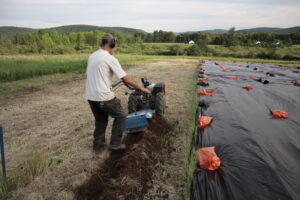
Experimental method 1: Tarp + Mulch
In early May, furrows were prepared in 200’ rows using a rotary plow. The furrows were ~ 6” deep and the swath of soil disturbance ~ 1’ wide. A 20’ x 200’ 6 mil tarp was applied to the plot and left on for 4 weeks to create a stale seed bed. The tarp was held down by sandbags placed ~10’ apart. The tarp was removed in early June and seed potatoes planted into the furrows. The furrows were covered by hoeing in soil previously thrown up by the rotary plow. In late June, after potatoes emerged and were 4-6 inches tall, the soil directly adjacent to the planting zone was lightly cultivated (~ 2 inch deep) using a 30” tiller attachment with precision depth roller. Loosened soil was hilled (~6” high) against the vine and the entire 20’ x 200’ plot was then immediately heavily mulched with 50 small bales of hay, paying particular attention to covering the soil near the planting zone.
Experimental method 2: Tarp alone
Furrowing, tarping, planting, cultivation and hilling were performed exactly as described above but the plot was not mulched.
Experimental method 3: Mulch alone
For this plot, the rye cover crop was left to grow until early June. The plot was then mowed very close to the ground using a flail mower and immediately after this the furrows were prepared, the seed planted and covered, as described above. In late-June the plot was lightly cultivated, hilled, and mulched as described above.
Figure 1. Project timeline and field layout overview
Description of data collection
Data was collected at time points as listed in Figure 1 and also described below.
Soil water content - soil samples (0-8 inches depth) was collected in plastic bags two times (early May, and early June). The bags were stored in a freezer until all samples had been collected. They were weighed using a milligram-level scale, followed by drying for 24 hours at 100 degrees C in a lab oven. The % water content was then calculated.
Soil temperature- were recorded continuously from the point of field prep to harvest with digital thermometers that were borrowed from Cornell Small Farms Program.
All labor hours that related to field preparation, planting, cultivating, hilling, harvesting and sorting were counted, as these hours would go into determining the profitability of the operation. Hours that are only related to other data collection or grant requirements were not counted. Ultimately we hoped to be able to compare the profitability for the 3 growing methods.
Weed germination within the 3 planted strips in each experimental plot was assessed once during the study (mid June, before cultivation and hilling). A ¼ meter quadrant was used to take weed counts for every 40 ft down each row (at 40’, 80’, 120’, and 160’ from the start of each row).
Mature weed count- for the sake of this experiment, we defined mature weeds as any plant other than potato (including regrowth of rye) that was taller than the mature potato vines before they significantly senesce. This was assessed once, in mid September, before harvest. For each row in a plot we counted mature weeds within a 1 meter quadrant at 4 places, 40’, 80’, 120’ and 160’ from the start of each row.
Nitrate level- This was assessed two times throughout the study for each plot: early May (pre-tarp) and early June (post-tarp). Samples were taken at 0-8 inches depth. In particular we were interested in the role that tarping may have played in soil nitrogen levels.
Active C and Soil Respiration- these were measured once for each plot, at time of harvest. We were interested in seeing if there was any difference in overall soil health and soil microbial activity as a result of the 3 treatments.
Predicted Autoclave-Citrate Extractable (ACE) Protein Test- this test was used to determine the fraction of a SOM that was present as proteins (this is associated with the overall soil health and biological quality of the soil). This test was also performed at time of harvest for each experimental plot.
pH and Nutrient Testing- samples were taken in fall of 2020 to get a baseline estimate of nutrient availability, organic matter % and pH value of the soil.
All soil testing for biological indicators was conducted by Cornell Soil Health Testing Laboratory (CSHTL). Soil nitrate levels, baseline pH and baseline nutrient testing was performed by Dairy One. Soil samples were collected according to the directions for each particular test. For each test, we took samples from 4 locations (40’, 80’, 120’ and 160’ from the start of each row) and included samples from each of the 3 rows within each experimental plot. They were mixed in a bucket and then the composite sample sent in for testing was removed from this, ensuring that the entire plot was represented.
Harvest:
Pontiac Red was harvested in late September, Keuka Gold in early October and Red Maria late October. In our experience, if the field is mulched well enough so that soil does not dry out, and tubers are harvested before the plants completely senesce, the process of harvesting by hand is greatly simplified. After harvest, potatoes were sorted into marketable and non-marketable (sun-greened or vole-chewed) groupings and weighed.
Results and discussion
In conducting this research project, we sought to optimize a potato growing method that had previously included strip-tillage and heavy mulching through the introduction of tarping. We hoped to assess the role of tarps and heavy mulching, together and alone, to affect: 1) the weediness of the field, 2) a suite of biological, chemical and physical measurements, and, 3) marketable yield of harvested tubers along with an analysis of labor efficiency. These data are all provided in attached spreadsheets . The general results for each along with a brief discussion of importance is provided below:
Weed analysis:
-
- Early summer:
- Tarps were successful in terminating the rye cover, as evidenced by almost complete lack of rye-regrowth in T and T+M plots yet rye covered about 1/3 of the plot in the M-only treatment.
- In T and T+M treatment, perennials such as goldenrod, Rubus (sp.) and milkweed were the dominant weeds
- Late summer:
- Potato plants were senescing, with many not standing upright at all.
- The T-only plot treatment had substantially more weed coverage between rows: (92% versus 30% for T+M and 45% for M-only)
- The T-only plot treatment had substantially more mature goldenrod than the other two treatments. It also had a mat of fine smaller weeds growing, most of which would not have reached the potato canopy and so would not likely have been a great concern.
- Rye regrowth covered ~15% of the ground between rows in the M-only plot and was completely absent in both T+M and T-only plots.
- Regardless of the management technique, none of the three plots were overrun with weeds.
-
We feel that tarping in conjunction with mulching seems to have a synergistic effect in reducing weed pressure.
- Early summer:
Soil physical, chemical and biological data
soil physical, chemical and biological data
- Soil water content:
- T-only was the driest (22.5% water) compared to T+M (24.3%) and M-only (25.5%)
- Regardless, the difference in soil water percentage for the three treatments was insignificant.
- This was as expected, given the consistency and quantities of rainfall received throughout this study period. In 2021, rainfall in this area deviated from the norm (~18" of rain throughout the growing season of May and September) with greater than 25" rain over this same period.
- We hypothesize that if it were a dry year (or even normal rainfall) that the T-only treatment would have had a harvest yield that diverged markedly from both treatments that involved mulching. This has been our experience in the past.
- Soil health (biological) measurements:
- All 3 treatments had “very high” ratings for active carbon, respiration and ACE protein, but the T+M had slightly lowest for each category. it is not clear why this was the case.
- We anticipated that soil health parameters such as those measured in this study would not be affected much during one growing season without extreme differences in soil management.
- Old pasture fields, such as the one on which we conducted this study, are expected to be relatively health soils as they have year-round living cover and have had very little, if any, soil disturbance in many years.
- Soil nitrate levels:
- Average nitrate levels increased fourfold in the T+M soil (17 ppm) from baseline (4 ppm) and also compared to M-only (4.5 ppm). T-only sample averaged 15 ppm nitrate.
- These data seem to indicate that the increase in soil nitrate was a causative factor in the marketable yields obtained.
- Tarps have been shown in other studies to increase nitrate levels in soils, possibly by speeding up decomposition of organic matter or by minimizing "tie up" of nitrogen by actively growing cover crops.
- Soil temperature:
- Soil temperatures were only affected during the time that the tarp was in place.
- both daily extreme soil temps, high and low, under tarps were consistently a 2-5 degrees higher during the coverage period but returned to baseline within a week after the tarp was removed.
- We hypothesize that soil temperatures would actually have been higher had the tarp sat very tightly on the ground (we put the tarp down after furrows were made in both T and T+M plots. The soil thrown to one side of the furrow caused the tarp to be up to 6 inches off the ground surface and over the 4 weeks it was in place eventually started to loosen and billow on hot days).
Yield and labor data
Potato yield
- Pontiac Red (early variety) germinated poorly throughout all 3 treatments and also in one other separate potato field, likely due to poor potato seed quality. Pontiac Red had similar marketable yields for all 3 treatments
- Red Maria (late variety) did the best in all 3 treatments.
- Keuka Gold showed the most notable benefit to the T+M treatment
- Both Keuka and Red Maria performed best in T+M
- All rows showed a marked decrease in productivity in the last ~100 ft of each row. The soil here was rockier and also had correspondingly lower nitrate levels. The potato vines were noticeably smaller and had fewer tubers. There was also more deer pressure at the ends of the rows, especially as the young vines emerged early in summer.
- Yield of marketable tubers summary:
-
-
- M-only- 544 lb total, 0.90 lb/ ft
- T+M- 736 lb total, 1.23 lb/ft
- T-only- 525 lb total, 0.88 lb/ft
-
-
-
-
-
- Pontiac red- 309 lb total, 0.51 lb/ft
- Keuka Gold- 632 lb total, 1.05 lb/ft
- Red Maria- 864 lb total, 1.44 lb/ft
-
-
Tuber quality
- Weight and percentage of vole-chewed tubers were both highest in M-only treatment.
- Weight and percentage of greened tubers were also both highest in M-only treatment.
- Mulch-only plot was closest to fallow edge of field with waist-high goldenrod and grasses by the end of the summer. Therefore, it likely was the best habitat for rodents. We are not sure why this plot also had highest percentage of greened potatoes.
- Tarping seemed to cause no increase in vole-chewed tubers.
Labor hours by category
- Each task hour directly associated with production (field prep, tarping, planting, removing tarp, mulching, mowing, harvesting, washing and sorting) was assigned to a particular treatment (T, T+M, or M) or divided among whichever treatment(s) it applied to.
- Data collection (weed survey, soil sampling, etc.) was not included in determining labor productivity.
- Filling sand bags was amortized: assuming that the bags will be functional for at least 5 years, only 1/5th of the total amount of time spent filling bags was considered for the sake of determining labor productivity. Transport of tarp and bags was not included.
Ratio yield to labor hours
- T+M and M had nearly similar ratio of marketable yield to labor hours.
- Tarping requires a significant investment in labor that may be offset by the increased yield.
- Tarping alone would likely have been far less productive had the season been dry or even normal.
- Mulching seems indispensable for weed prevention and also moisture retention.
In this study we sought to assess the role of tarps and mulching in a reduced-tillage potato growing method. Specifically, we wanted to optimize our method that had previously included strip-tillage and heavy mulching through the introduction of tarping. We hoped to assess the role of tarps and heavy mulching, together and alone, to affect: 1) the weediness of the field, 2) a suite of biological, chemical and physical measurements, and, 3) marketable yield of harvested tubers along with an analysis of labor efficiency. A 60 x 200 ft field was planted with overwintering rye cover crop in the fall on 2020. The following spring, a rotary plow attachment for aa BCS tractor was used to make furrows in part of the the field. Tarps were then used to terminate the cover crop on 2/3rds of the experimental field for 4 weeks. The rye in the other 1/3 of the field was allowed to grow to anthesis for the additional 4 weeks. It was then mowed and furrows were made in this portion of the field. Following tarp removal, the entire field was planted with three varieties of potatoes, an early, mid and late season variety. Three weeks later the field was light cultivated 2 inches deep and then 2/3rd of the field was mulched heavily with hay.
We found that weed pressure was least aggressive in the T+M plot while rye regrowth was only found in the M-only plot.
Most of the soil physical, chemical and biological tests performed yielded unsurprising results. However, tarping seemed to substantially increase the nitrate levels in soils which corresponded well with increased yield. Our analysis of labor hours indicates that this method of reduced-tillage potato growing, while labor-intensive, is financially sustainable: we obtained yields of marketable potatoes of up to 17 lb per labor hour. Considering that we sell out potatoes for around 4$ per lb, that results in over $60 of gross sales for each labor hour invested.
We do think we met all of our goals in this study and intend on continuing to employ both tarping and heavy mulches with our reduced tillage potato growing.
Education & Outreach Activities and Participation Summary
Participation Summary:
We submitted an article the Spring 2022 issue of the Small Farms Quarterly, a publication of the Cornell Small Farm Program that is accessible in print and online (40,000+ print readers). We expect publication by mid-April 2022. https://smallfarms.cornell.edu/quarterly/
Article Title: To tarp, to mulch or to do both, that was the question
Article Lede: CSA Farm experiments to minimize inputs, mechanization and soil disturbance in their market-scale potato growing operation
Authors: Bob Tuori1, Ryan Maher2, Michael Salzl1
1Farmers at nook&cranny farm
2Research and Extension Specialist, Cornell Small Farms Program
We presented information and results from this study at two farming conferences reaching farmers and educators in NY and the Northeast region.
1) PASA Sustainable Agriculture Conference. Lancaster, PA. 02/11/22. Using Tarps to Reduce Tillage on Small Vegetable Farms. Ryan Maher and Bob Tuori. 1 hr. 60 attendees. Oral presentation.
2) Empire State Producers Expo. Virtual. 03/8/22. Soil Health Session (Part 2) – Strategies for Small Farms. Keeping beds and fields covered: Fitting in the suite of soil health practices on a market farm. Bob Tuori. Session Organized by: Ryan Maher. 30 min. 25 attendees. Oral presentation. This presentation was recorded and published on the Cornell SIPS YouTube channel for broader viewing (64 views, accessed 3/29/22) https://www.youtube.com/watch?v=YbpZfDigrEw&list=PLHPXm2Es8aQCnuT98FsLlSfsEJ_4G9nwm&index=7
We are producing a short educational video (approx. 3 min) in collaboration with the Cornell Small Farms Program to share the inspiration and approach to this experiment. It will feature an on-farm interview and footage taken throughout the duration of the study. It will be published in concert with the SFQ article and posted on the Cornell SFP YouTube channel (26,000 subscribers), anticipated April 2022. https://www.youtube.com/c/cornellsmallfarms
Learning Outcomes
After conducting this research, I feel keenly aware of the importance of experimentation in farming successfully. Although I have been experimenting throughout my time farming, I have never done it so systematically, and never with a faculty research collaborator with whom I could routinely discuss methods and results. My professional association with Ryan Maher has been a great benefit for me as both a farmer and researcher. I hope to utilize his expertise in the future and would like to continue collaborating with him in reduced tillage farming methods.
Before this project, I was aware of the use of tarps in small-scale agriculture, but had not tried implementing them into our intensive vegetable system. I feel pretty confident that we will continue using tarps in myriad ways as we continue to experiment with ways that they can fit into our rotations and on our small, intensive operation. In particular we will continue to use tarps with field-grown potatoes for termination of rye cover crop and weed suppression in conjunction with mulch. We are currently also experimenting with tarping in high tunnels and also with solarizing clear tarps for quick summer turn-around of beds.
This project has made me much more focused on soils, especially the importance of reduced tillage methods. My knowledge of the effects of tillage on soils has deepened considerably. My knowledge and skills in soil sampling methods, soil health metrics and soil nitrate chemistry have expanded as a result of this research. I have introduced tarping and reduced tillage methods to my high school sustainable agriculture course and recently got a grant from a local nonprofit to purchase tarps for cover crop termination at our school garden plot and high tunnel.
Project Outcomes
We will always use tarps in conjunction with mulching for our field-grown potatoes as a result of this project. We are also experimenting with other way to utilize tarps on our intensive small farm.
In general, I think that having this research as an active part of the farm last season was greatly appreciated by all of the crew. A few of them actively took on responsibilities for data collection and careful tuber harvest, washing and sorting and so they gained from this project. I very much appreciated being a part of scientific research again, after a long absence from academic plant science research.
I think that this work turned out very well: we will continue to use both tarping and mulching in our potato-growing operation. the one change I will make in the future is to put in rotary plow furrows only after the tarp has been removed. We found that walking on the furrowed, uneven field during the the securing and removal of the tarp was challenging. I am not sure that there was much of any benefit of furrowing before tarping as evidenced by the conspicuous amount of small weeds seen in furrows on the day the tarp was removed, 4 weeks after it was secured in place. So in the future we will place the tarp down directly on the mature cereal rye, remove 4 weeks later and then furrow on the same day that we plant. With a great deal of practice securing and moving tarps over last season our crew got much better and much more efficient at the process. In the future I feel pretty confident that we can do the tarping portion of this work in nearly half of the time, greatly increasing our labor efficiency.
